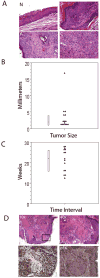A mouse model for human anal cancer
- PMID: 20947489
- PMCID: PMC3006089
- DOI: 10.1158/1940-6207.CAPR-10-0086
A mouse model for human anal cancer
Abstract
Human anal cancers are associated with high-risk human papillomaviruses (HPV) that cause other anogenital cancers and head and neck cancers. As with other cancers, HPV16 is the most common high-risk HPV in anal cancers. We describe the generation and characterization of a mouse model for human anal cancer. This model makes use of K14E6 and K14E7 transgenic mice in which the HPV16 E6 and E7 genes are directed in their expression to stratified squamous epithelia. HPV16 E6 and E7 possess oncogenic properties including, but not limited to, their capacity to inactivate the cellular tumor suppressors p53 and pRb, respectively. Both E6 and E7 were found to be functionally expressed in the anal epithelia of K14E6/K14E7 transgenic mice. To assess the susceptibility of these mice to anal cancer, mice were treated topically with dimethylbenz[a]anthracene (DMBA), a chemical carcinogen that is known to induce squamous cell carcinomas in other sites. Nearly 50% of DMBA-treated HPV16 E6/E7 transgenic mice showed overt signs of tumors, whereas none of the like-treated nontransgenic mice showed tumors. Histopathologic analyses confirmed that the HPV16 transgenic mice were increased in their susceptibility to anal cancers and precancerous lesions. Biomarker analyses demonstrated that these mouse anal cancers exhibit properties that are similar to those observed in HPV-positive precursors to human anal cancer. This is the first mouse model for investigating the contributions of viral and cellular factors in anal carcinogenesis, and should provide a platform for assessing new therapeutic modalities for treating and/or preventing this type of cancer.
©2010 AACR.
Figures



References
-
- Ries LAG, M D, Krapcho M, Stinchcomb DG, et al., editors. SEER Cancer Statistics Review. Bethesda, MD: National Cancer Institute; 1975-2005.
-
- Cress R, Holly E. Incidence of anal cancer in California: increased incidence among men in San Francisco, 1973-1999. Prev Med. 2003;36:555–60. - PubMed
-
- Hoots B, Palefsky J, Pimenta J, Smith J. Human papillomavirus type distribution in anal cancer and anal intraepithelial lesions. Int J Cancer. 2009;124:2375–83. - PubMed
-
- Chin-Hong PV, Berry JM, Cheng SC, et al. Comparison of patient- and clinician-collected anal cytology samples to screen for human papillomavirus-associated anal intraepithelial neoplasia in men who have sex with men. Ann Intern Med. 2008;149:300–6. - PubMed
Publication types
MeSH terms
Substances
Grants and funding
LinkOut - more resources
Full Text Sources
Medical
Research Materials
Miscellaneous

